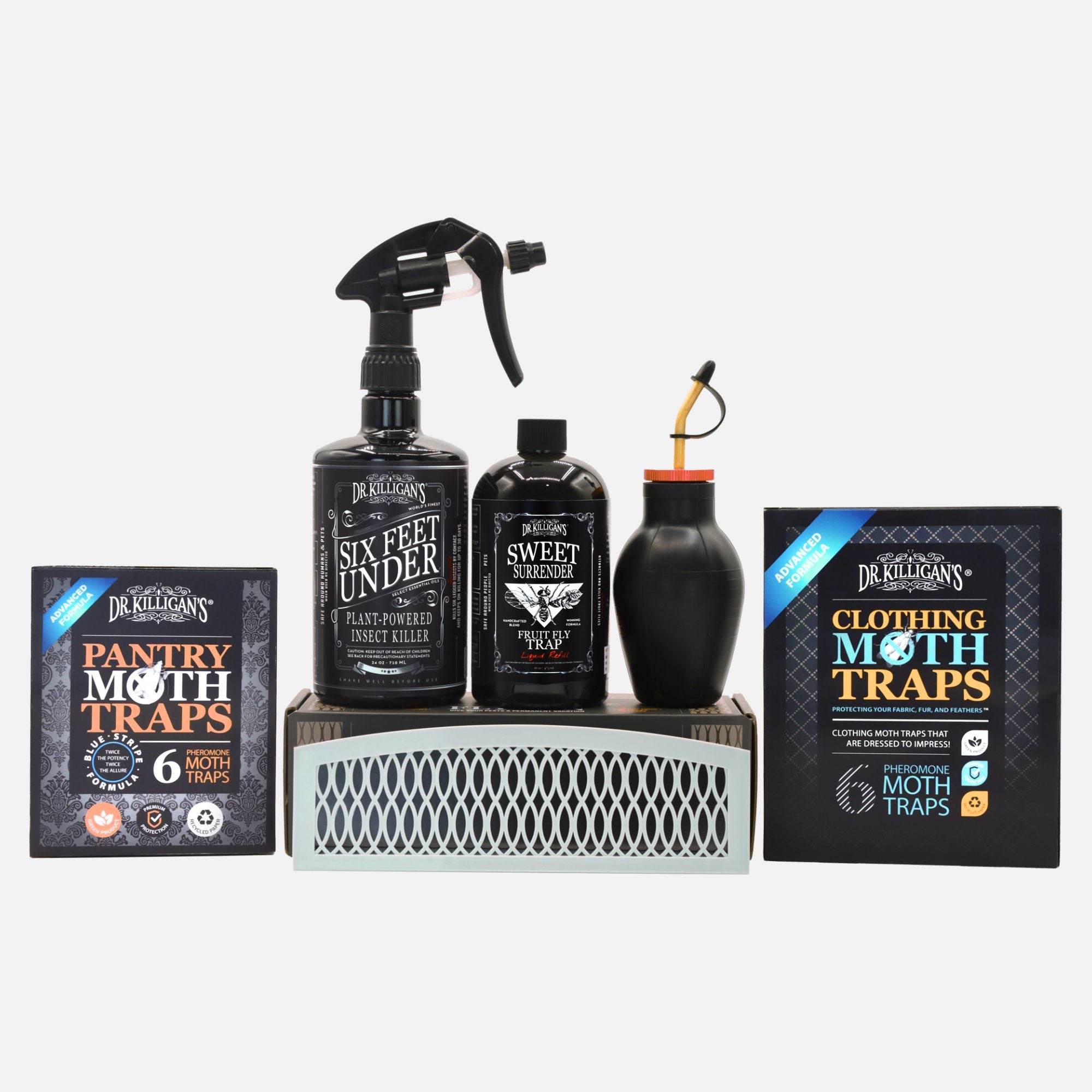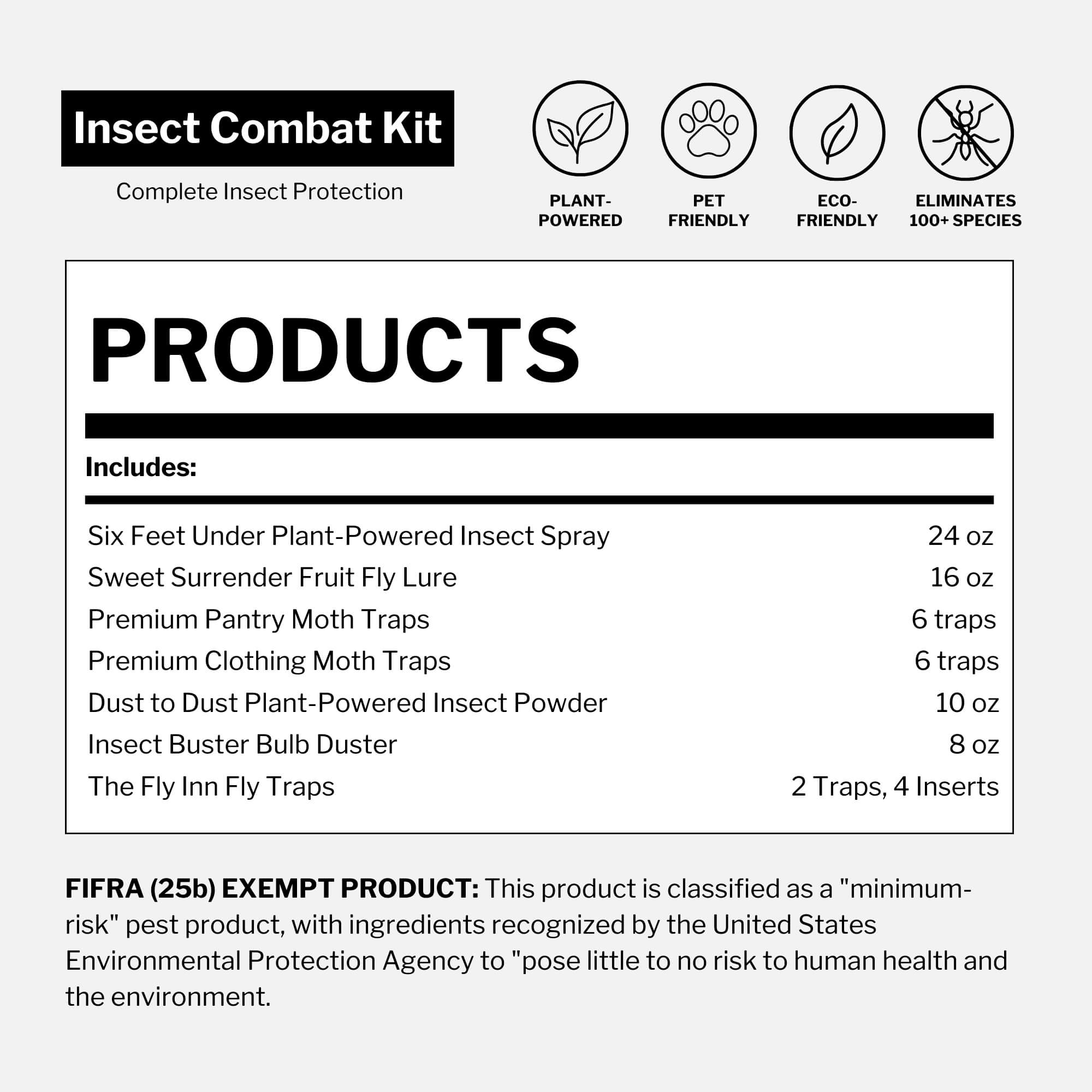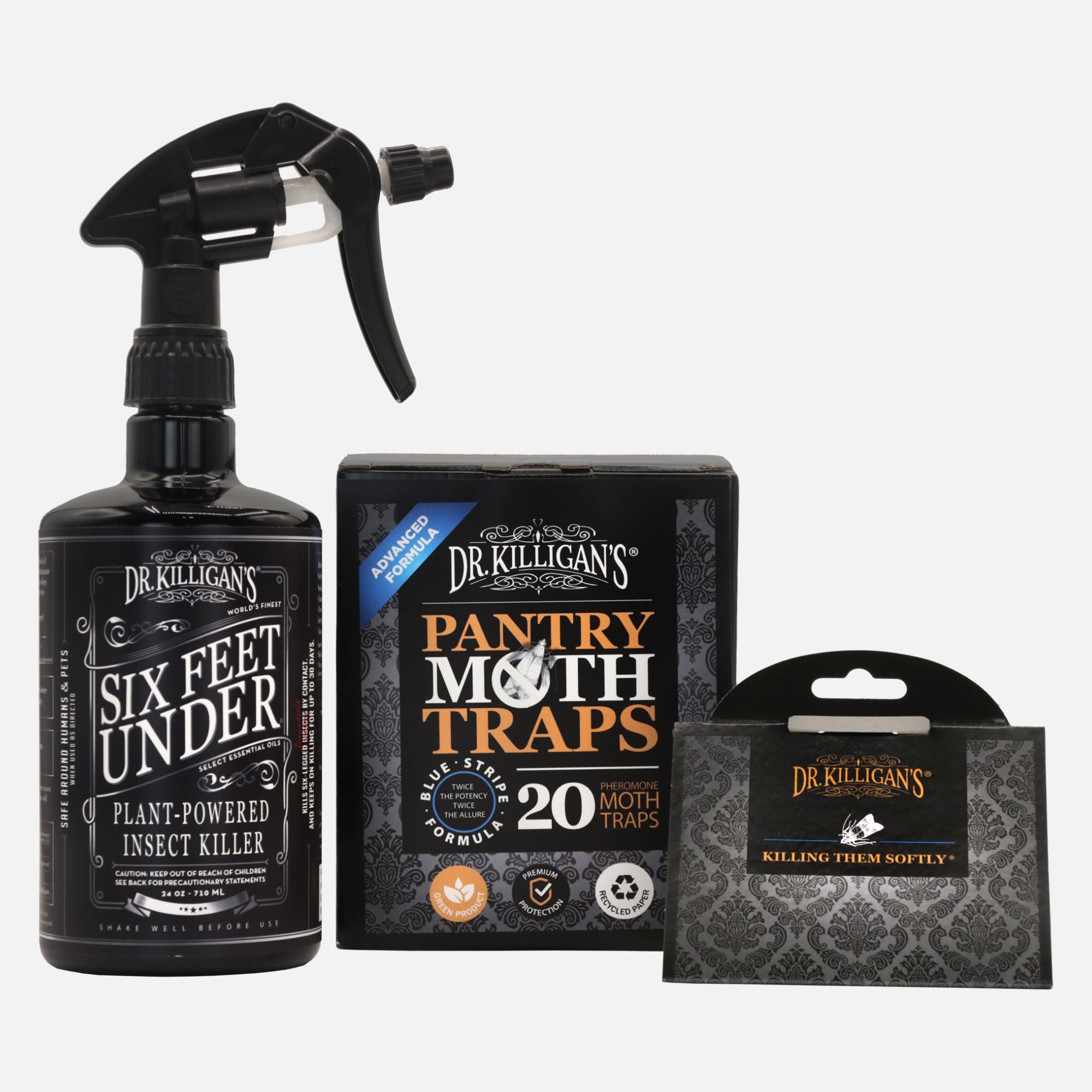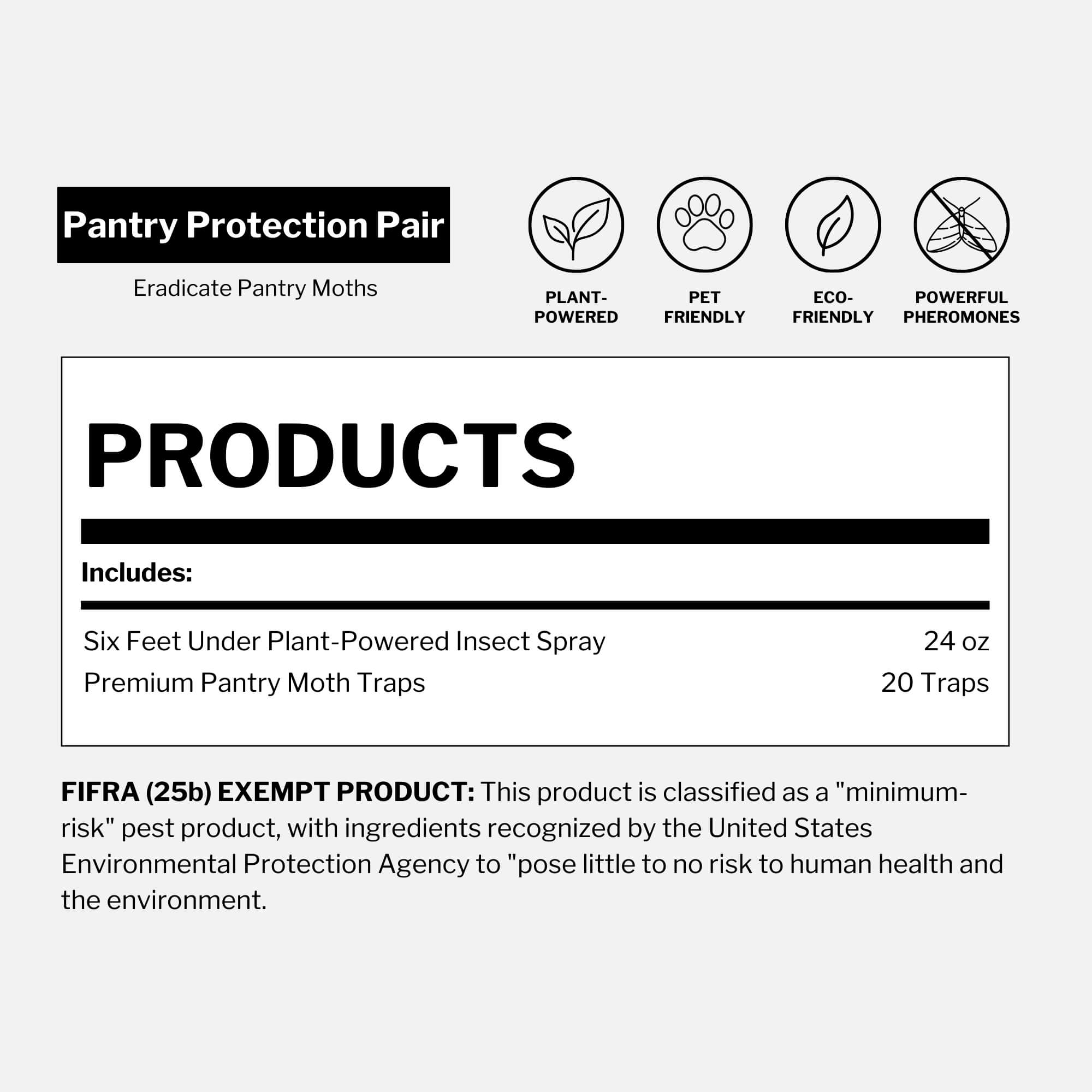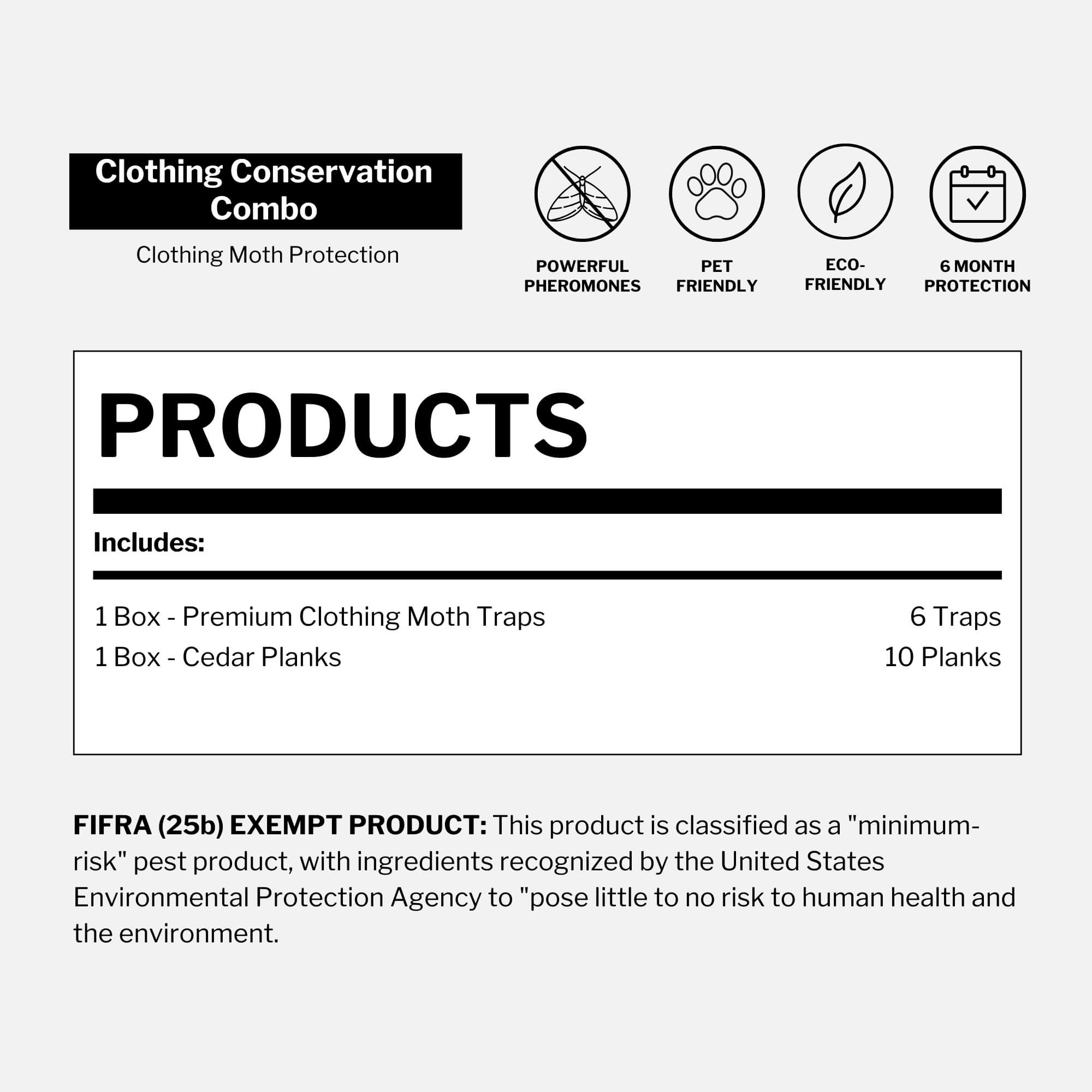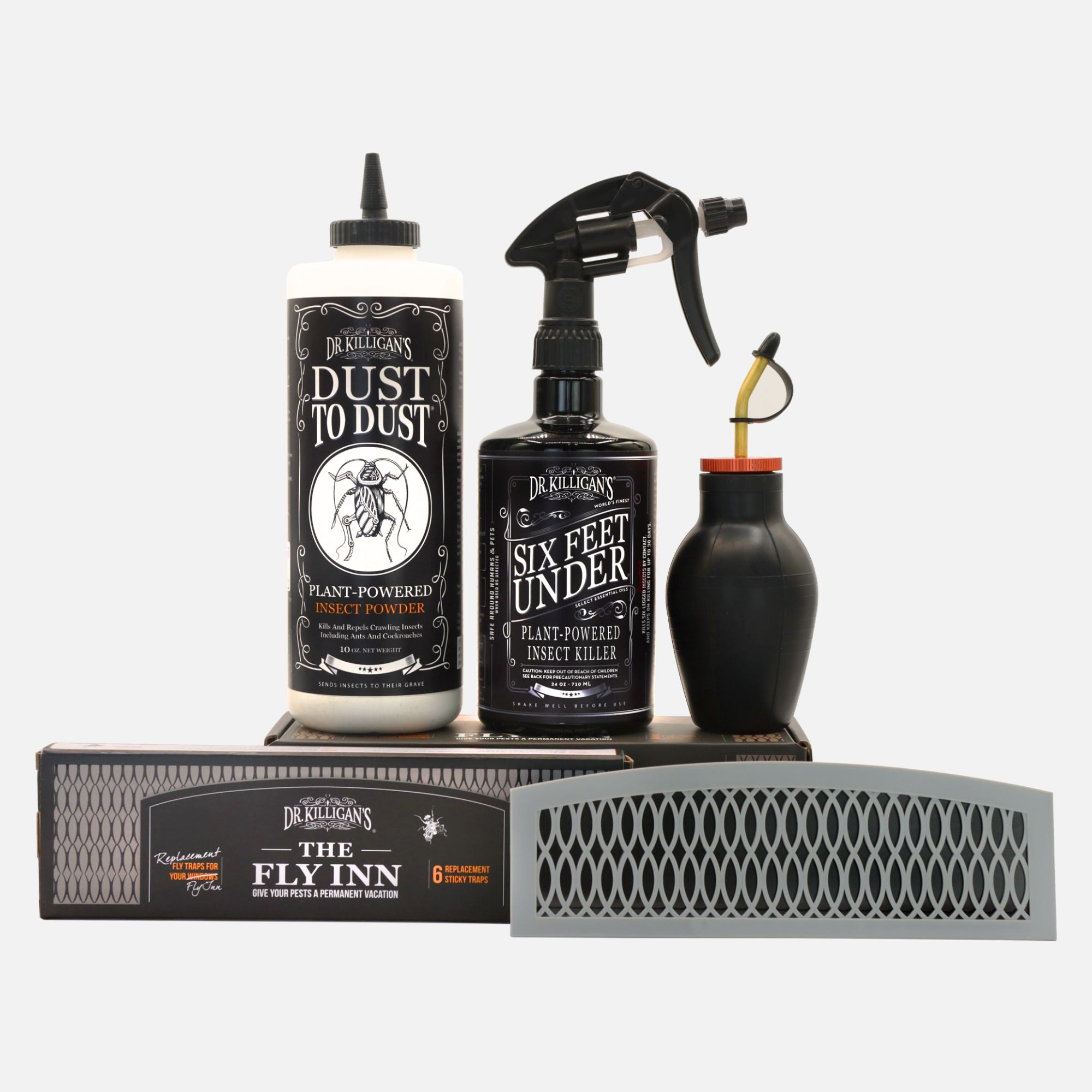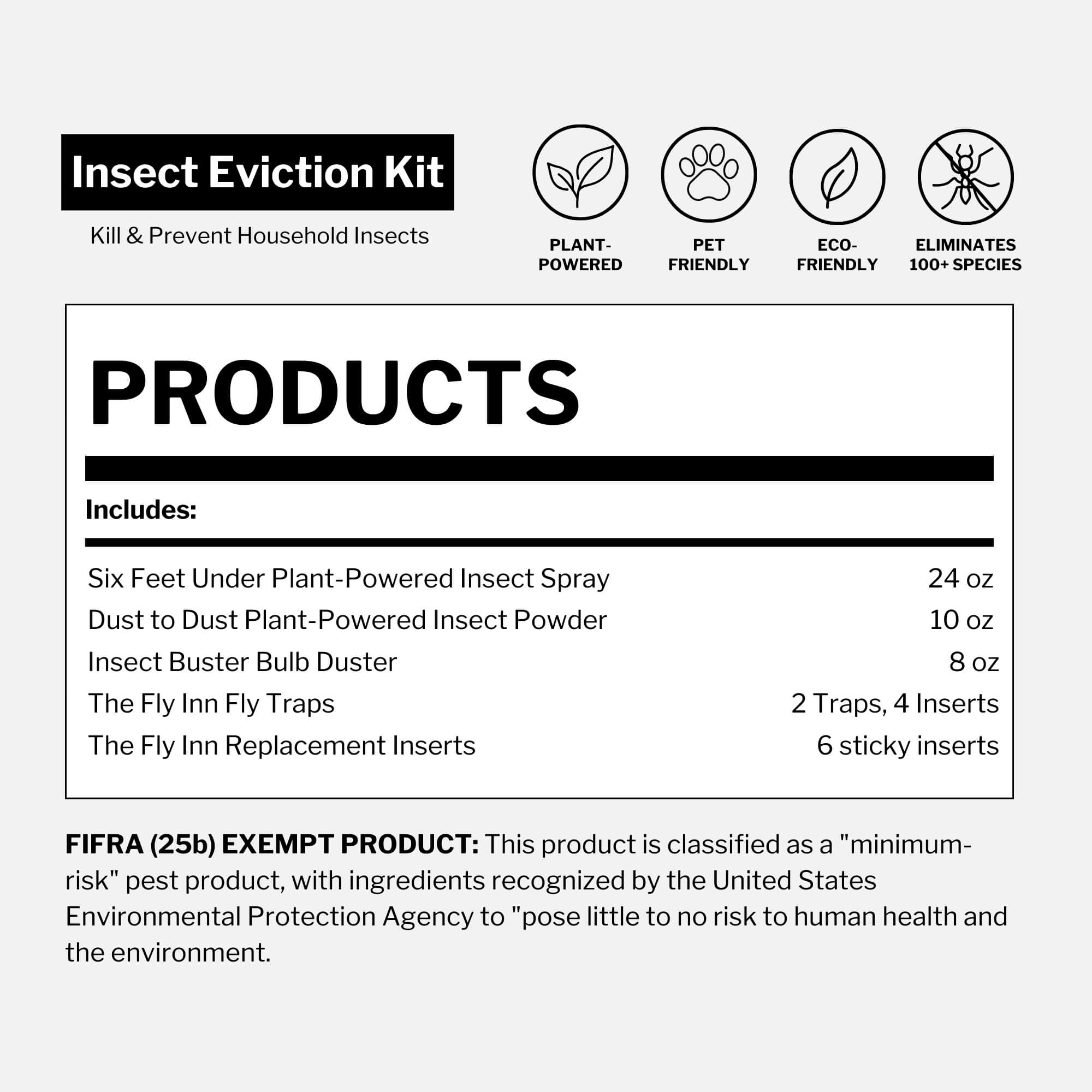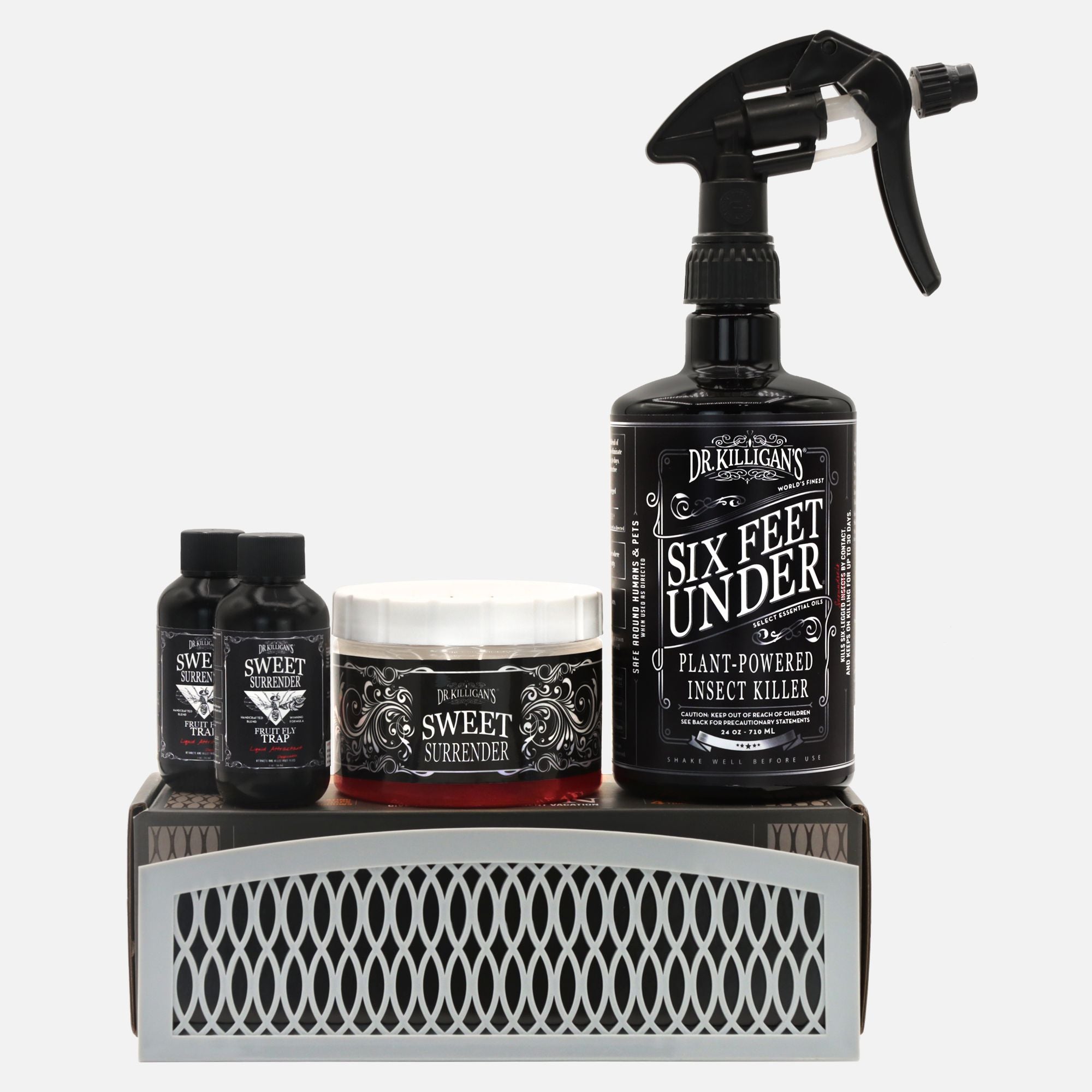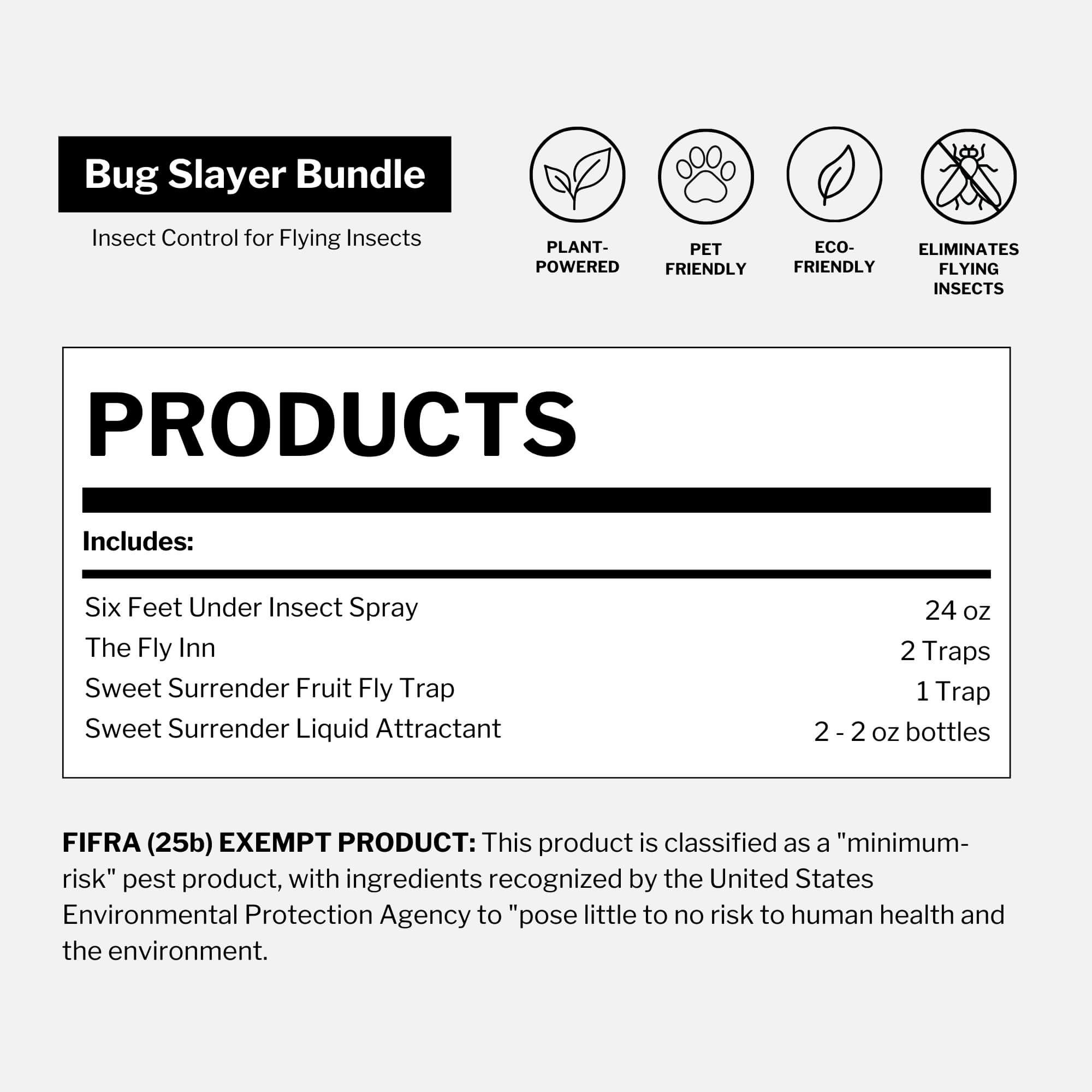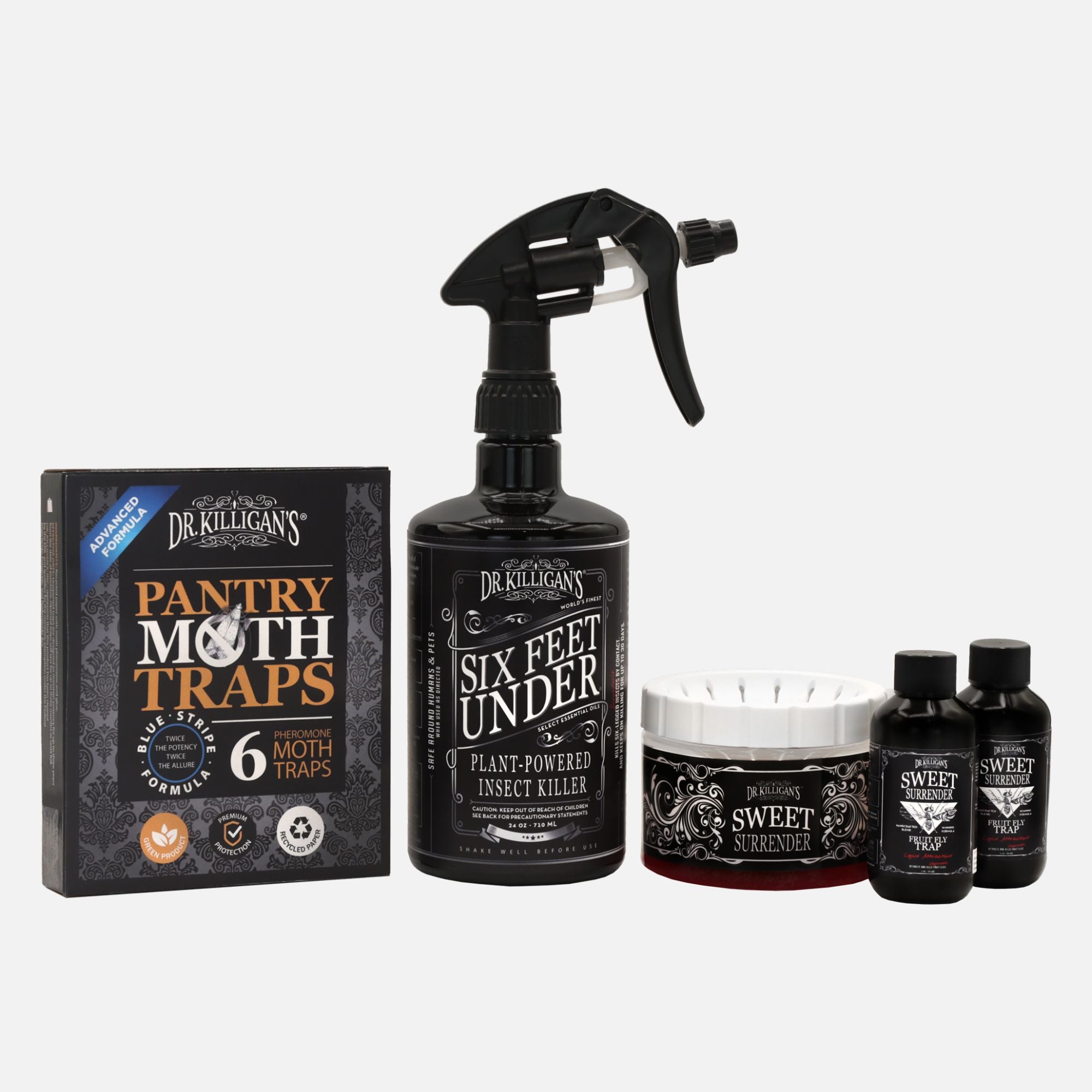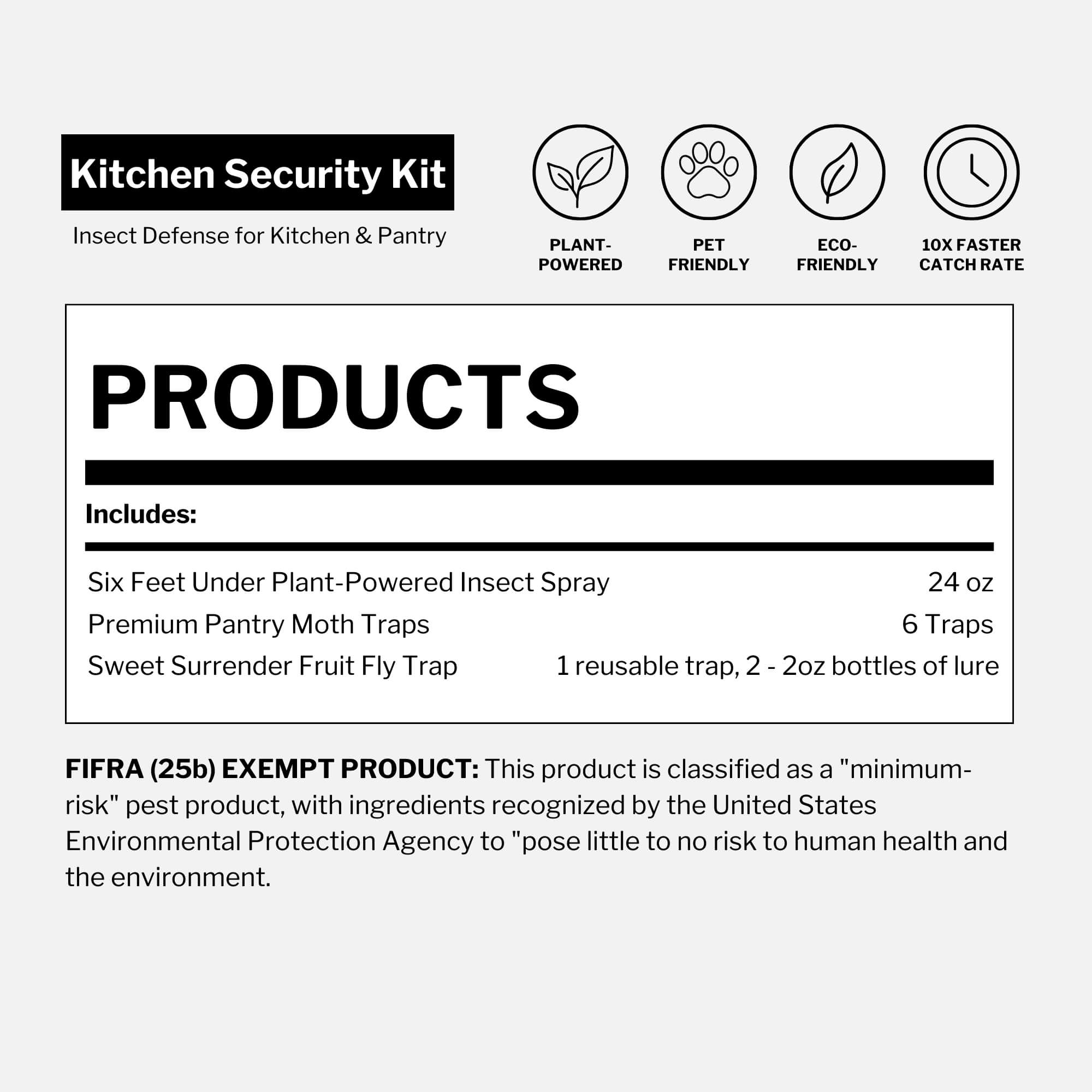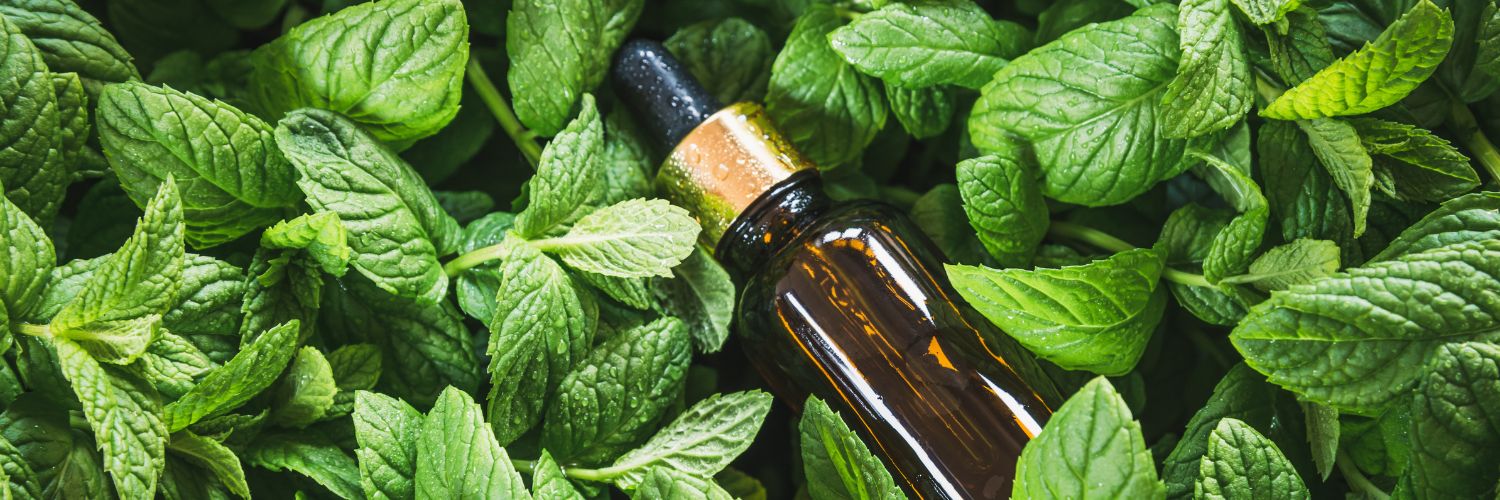Published April 4, 2024 • Updated November 22, 2025
Reviewed by Julie Miller, BA in Language Arts, Editorial Lead, Dr. Killigan’s
TL;DR: The grey house spider is one of the most frequently searched indoor species. Whether people search for “grey spider,” “gray spider” or “grey house spider,” they are usually talking about the same quiet, harmless arachnid that prefers to avoid people. This guide helps you identify the grey house spider and eight other common house spiders, understand which species are harmless, which require caution and how simple prevention or plant-powered tools can support a calmer home.
Spiders tend to startle us for many reasons: their silent movements, their eight-legged shape or the unexpected places they appear. Yet despite their unsettling entrances, most household spiders are harmless and even helpful.
Among the species you are most likely to see, the grey house spider (Badumna longinqua) stands out. In online searches and forums, it is often grouped under broad terms like “grey spider in house” or “common grey spider,” but it is a specific, reclusive species most often found in quiet, sheltered spaces. Though rarely seen in the open, it contributes to natural pest control by preying on insects.
What are spiders? Are they insects?
Spiders often get grouped with insects simply because they are small, quick and share our living spaces. But biologically, they belong to an entirely different class.
Spiders are arachnids, not insects. They have:
- eight legs
- two main body segments
- no antennae
- multiple eyes arranged in pairs
Insects, by contrast, have six legs, antennae and three distinct body segments. That difference alone places spiders in their own category of predators.
This distinction matters because house spiders behave differently from household insects. They do not feed on crumbs or stored food. Instead, they prey on insects like flies, mosquitoes and moths—making them an unintentional line of indoor pest control.
What makes spiders unique?

- They breathe differently: Instead of lungs alone, many spiders use book lungs and tiny air tubes called tracheae, which help them stay active even in tight spaces.
- They can recycle their silk: Some orb-weaving spiders eat parts of their damaged webs to reclaim the proteins and spin fresh silk.
- Not all spiders make webs: Roughly half of spider species do not use webs to catch prey and instead hunt or ambush insects directly.
- Silk is their lifeline: Spiders use silk as a safety line, a way to carry air underwater and even a parachute for young spiderlings as they disperse.
What is the grey house spider?
The grey house spider (Badumna longinqua) is a quiet, reclusive species that often slips into homes unnoticed. It shows up in search engines under many names—"grey house spider", "gray house spider", "grey spider in house", "even small grey spider"—which leads many people to assume these terms describe different spiders. In most cases, they refer to this same species.
 Grey house spider - Badumna longinqua
Grey house spider - Badumna longinquaFun fact: The grey house spider spins a notably thicker, more irregular silk than many other house spiders. These dense silk retreats serve as both a hiding place and a protective shelter.
Native to Australia but now found in parts of the United States, including California and Florida, the grey house spider prefers undisturbed places such as window frames, eaves, garden sheds and corners that stay dry and sheltered. It builds a dense, irregular silk retreat rather than a delicate web, giving it a thicker, “messy” appearance that helps conceal the spider inside.
Despite its surprising look, the grey house spider is non-aggressive and not considered dangerous to people or pets. It avoids contact, feeds mainly on insects and plays a small but helpful role in reducing household pests like flies and mosquitoes.
9 common house spiders (including the grey house spider)
House spiders vary widely in size, color and behavior, yet most are harmless and avoid contact with people. Many appear more often in autumn when males leave their webs in search of females. Below are nine types of house spiders commonly found indoors, including the often-searched grey house spider.
Grey house spider (Badumna longinqua)
A small, reclusive spider with mottled grey coloring. It builds dense silk retreats in quiet, sheltered areas like window frames, eaves and garden sheds. Non-aggressive and not considered dangerous.
Brown house spider or False widow (Steatoda grossa)
Dark brown with a rounded abdomen. Sometimes mistaken for a black widow due to its shape, but far less concerning. Builds messy, irregular webs in undisturbed indoor corners.
American house spider (Parasteatoda tepidariorum)
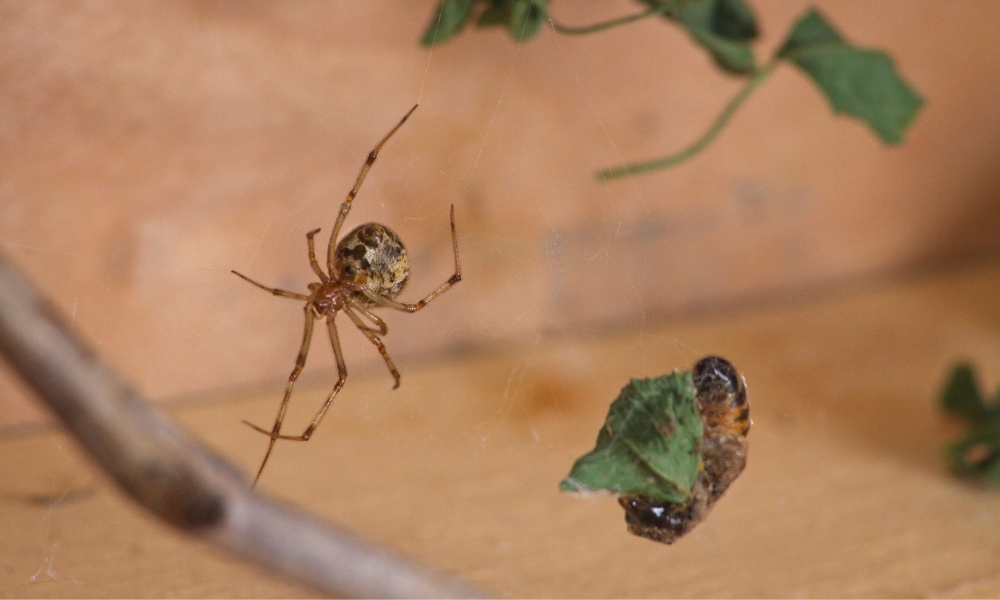 American House Spider
American House SpiderOne of the most common indoor cobweb builders. Brown to grey in color and often found in corners, windows and ceiling junctions. Helps control flying insects.
Cellar spider (Pholcus phalangioides)
Tall, delicate and pale with very long legs. Common in basements and garages. Known for its shaky, vibrating defense behavior when disturbed.
Domestic house spider or Barn funnel weaver (Tegenaria domestica)
Brown and fast-moving. Builds funnel-shaped webs in crevices and darker areas. Often feared due to its speed but typically avoids human interaction.
 Barn funnel weaver
Barn funnel weaverGiant house spider (Eratigena atrica)
Large, brown and fast, often startling homeowners due to its size. Builds sheet-like webs with funnel retreats. Prefers to flee rather than bite.
Hobo spider (Eratigena agrestis)
Brown with subtle abdominal patterns. Creates ground-level funnel webs in basements or near foundations. Once thought dangerous, now considered medically insignificant.
Southern house spider (Kukulcania hibernalis)
Light brown males roam widely indoors, while darker, larger females remain in their silk retreats. Common around windows, attics and eaves.
Yellow sac spider (Chiracanthium inclusum)
Pale yellow with slender legs. Active hunters that roam walls and ceilings at night. Can cause mild irritation if disturbed but does not seek out interaction.
How to identify which spiders are in your home
Trying to identify a house spider can feel overwhelming, especially when you are staring at a small grey spider in a corner and wondering what it is. These four steps will help you narrow it down without needing to be an expert.
1. Check the web type. Does your spider make a messy cobweb, a funnel web or no web at all?
- Messy cobweb → Often an American house spider or brown house spider (commonly in corners and around windows).
- Funnel web → Could be a domestic house spider or hobo spider (often near ground level, in basements or along foundations)
- No obvious web → Often a yellow sac spider or another wandering hunter that roams walls and ceilings at night
2. Look at the leg-to-body proportion. Are the legs noticeably long compared to the body?
- Very long, thin legs → Common in cellar spiders (sometimes called “daddy longlegs”), which are often found in basements and garages.
- Legs more proportionate and sturdy → Could be a domestic house spider, giant house spider or grey house spider, which tend to have thicker legs and stockier bodies.

3. Examine color and markings. Do you see any distinctive shapes or patterns?
- Violin-shaped marking on the back → May indicate a brown recluse. This species can cause medically significant bites and deserves caution.
- Red hourglass on the underside of the abdomen → Characteristic of black widow spiders, another species that should be treated with care.
- No distinct markings, just brown or grey → More likely a common house spider, grey house spider or hobo spider, most of which are considered non-aggressive and avoid contact.
4. Note where you found it. Location offers useful clues:
- Basement or dark, damp area → Often a cellar spider or domestic house spider.
- Ceiling or upper wall corners → Common for yellow sac spiders and American house spiders.
- Near windows, doors or quiet crevices → Frequently where southern house spiders and grey house spiders build retreats and wait for insect prey.
These simple checks will not make you an arachnologist, but they can help you move from “mystery grey spider” to a likely identification and a clearer sense of whether the spider is harmless and best left alone or better managed with a calm, targeted response.
Dangerous spiders to watch for
These are the three dangerous house spiders worth knowing if you want to be cautious about identification.
Most house spiders are harmless and prefer to stay out of sight. Still, it is helpful to know the few species that deserve caution. These spiders are not aggressive, but their bites can cause medically significant reactions if they come into contact with humans. Clear identification matters, and if you’re ever unsure, it is best to avoid handling any spider directly.
Brown recluse (Loxosceles reclusa): A medium-brown spider with a distinct violin-shaped marking on its back. Brown recluses prefer warm, undisturbed areas like closets, sheds and woodpiles. They rarely seek out interaction, but their bites can cause localized reactions that require medical attention. If you suspect you’ve found one, give it space and avoid direct contact.
Black widow (Latrodectus): Easily recognized by its shiny black body and red hourglass on the underside of the abdomen. Black widows tend to hide in sheltered places such as garages, woodpiles and outdoor storage. They are shy and only bite when pressed or threatened, but their venom can cause significant discomfort. Careful avoidance is the safest approach.
Hobo spider (Eratigena agrestis): Once considered medically important, current research suggests hobo spider bites are far less concerning than once believed. They are brown, with subtle chevron-like patterns on the abdomen and build funnel-shaped webs near ground level. They avoid people, but their fast movement often leads to misidentification. If you see a funnel web near a baseboard or basement wall, a hobo spider may be nearby.
These species are the exception, not the rule. Most indoor spiders—including the grey house spider, cellar spiders and American house spiders—are timid, beneficial and part of a natural pest-control balance inside the home.
Spider lifespan: How long do common house spiders live?
Spider lifespans vary widely depending on species, environment and sex. Many common house spiders live for one to two years, but some can survive far longer when they remain undisturbed in steady indoor conditions.
In general, female spiders outlive males. This is partly due to biology: females continue building retreats, catching prey and producing egg sacs throughout their lives, while males often have one goal—mature, mate and decline soon after. In some species, males do not survive long past reproduction. In others, males may even be consumed by the female, a strategy that provides additional nutrients and may contribute to the female’s extended lifespan.
Here are a few examples that help put their longevity in perspective:
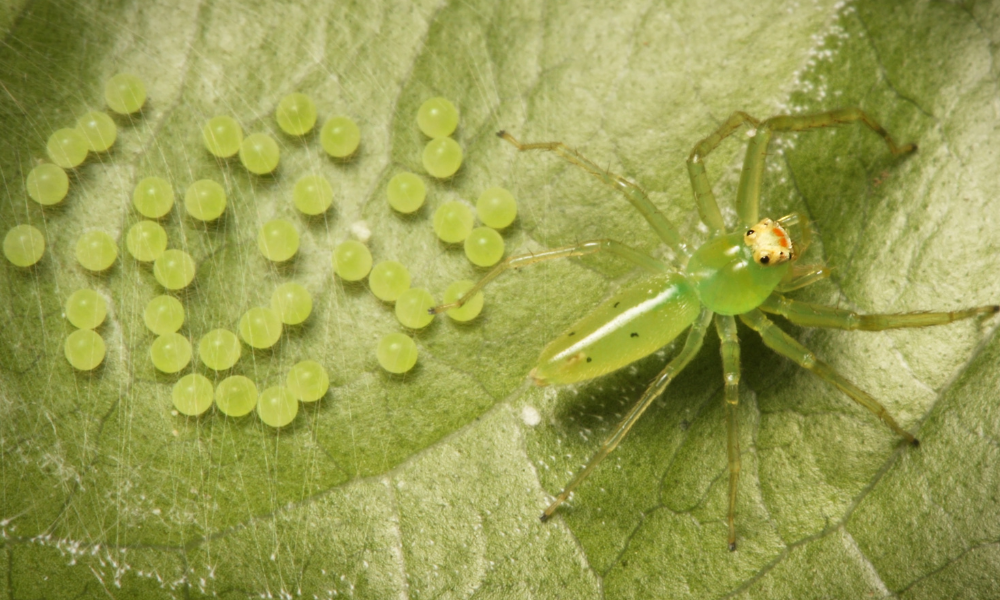 Magnolia green jumper
Magnolia green jumper- American house spider (Parasteatoda tepidariorum): Lives for about one year, though sheltered indoor spaces can extend that.
- Grey house spider (Badumna longinqua): Typically lives around one year, with some females lasting longer in quiet corners and undisturbed retreats.
- Barn funnel weaver (Tegenaria domestic): Can live up to seven years, especially when left alone in basements or storage areas.
- Black widow (Latrodectus)Females may live up to three years; males usually live one season.
- Tarantulas (Theraphosidae): Among the longest-lived spiders—some species reach 10 to 30 years.
- Wolf spiders (Lycosidae): Males often live less than a year, while females may survive several seasons.
- Trapdoor spider (Ctenizidae): Exceptional outliers: the oldest recorded individual reached 43 years.
Fun fact: In one species, Thanatus fabricii (which does not have a common name), males have been observed biting and gently restraining females with silk before mating. Researchers believe this unusual behavior helps the male avoid being eaten afterward.
Is it good to have some spiders in my house?
Most of the spiders you see indoors—even the small grey ones that startle you on a wall or near a window frame—are harmless and often helpful. They feed on insects that routinely make their way inside, acting as a quiet, built-in layer of pest management. While you do not need to welcome spiders into every corner of your home, allowing an occasional non-aggressive species to remain in an attic, basement or seldom-used area can support a more balanced indoor ecosystem.
Spiders prey on mosquitoes, flies, moths and even other spiders. In doing so, they help reduce nuisance insects and keep certain pest populations naturally in check. They do not seek out people, they do not forage for crumbs and they rarely leave their retreats unless searching for food or mates.
3 reasons to keep the occasional spider
- They reduce indoor pests: One spider can eat 2,000 insects in one year.
- They support healthier indoor spaces: By feeding on insects that can transmit diseases, spiders indirectly help maintain a cleaner, more comfortable environment.
- They keep each other in balance: Long-legged cellar spiders, for example, are known to prey on black widows, reducing interactions with more concerning species.
Fun fact: Huntsman spiders, jumping spiders and American house spiders have all been documented feeding on cockroaches—a small but effective contribution to indoor pest control.
How many spiders are there, really?
If you could zoom out above your home, you would see a quiet army of spiders at work in gardens, attics and window frames. Scientists estimate that, worldwide, spiders consume hundreds of millions of tons of insects each year—more than the weight of the entire human population. In one landmark analysis, Nyffeler and Birkhofer quantified this enormous ecological impact across global ecosystems
It is a vast, hidden effort that helps keep many pest species in check. So when you notice a single spider resting in a corner, it is not just a lone visitor. It is one small part of a much larger, global web of natural pest control working quietly in the background.
How to get rid of spiders in the home
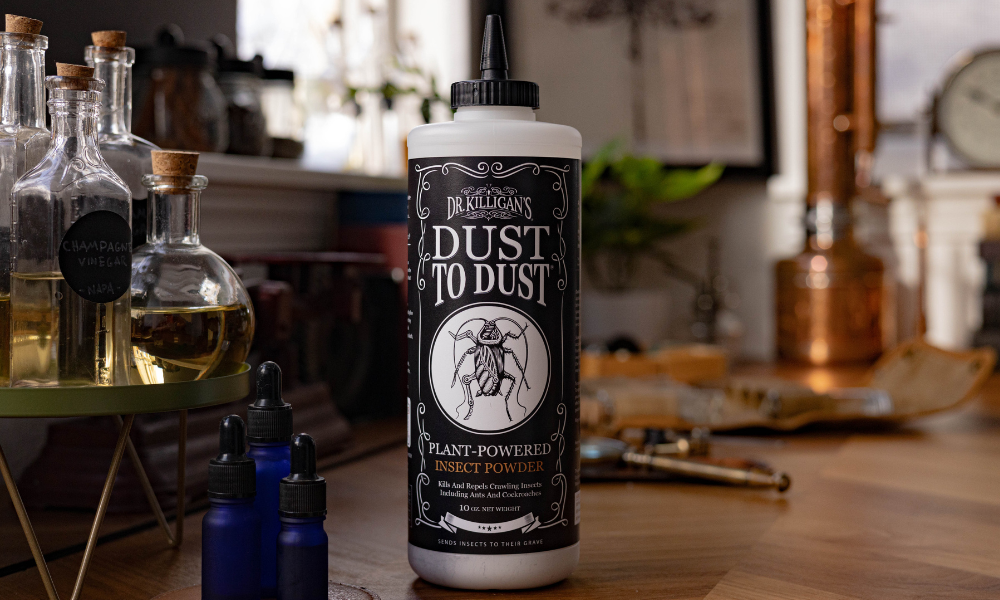
If you prefer fewer spiders inside, a steady, simple routine works better than one-time fixes. Most spiders come indoors while following insect prey, so reducing food sources and closing off entry points can make a noticeable difference. When you want additional support, plant-powered products can help you manage activity in a calm, targeted way.
1. Remove what attracts insects
Spiders often appear where insects gather. Reducing flies, moths and other small pests lowers the chances that spiders will settle indoors.
- Keep counters clear of crumbs
- Store food in sealed containers
- Address fruit flies quickly
- Empty indoor trash more often in warmer months
A home with fewer insects naturally becomes less interesting to spiders.
2. Declutter and reduce hiding places
Spiders prefer quiet, undisturbed spaces. Tidying storage areas, shaking out infrequently used linens and clearing piles of boxes removes many of the spots where spiders build retreats.
- Basements and garages
- Closets and storage shelves
- Behind furniture
- Window ledges and eaves
A little movement and airflow go a long way toward discouraging spider retreats.
3. Seal small gaps and entry points
Simple fixes help keep insects and spiders from entering.
- Repair torn screens
- Seal gaps around windows and doors
- Check weather stripping
- Use door sweeps where needed
These steps limit drafts and tiny openings that spiders follow indoors.
4. Use Dust to Dust Plant-Powered Insect Powder
For those who want a targeted approach, Dust to Dust Plant-Powered Insect Powder can help manage insect and spider activity. The formula uses silica to break down the protective wax layer on the exoskeleton of insects and arachnids. When applied in thin, even lines, it works best in areas where spiders and insects travel.
Where to use it:
- Along baseboards
- In corners
- Under appliances
- At entry points
- In cracks and crevices
5. Gently relocate or remove individual spiders
If you prefer not to harm a harmless spider, a simple glass-and-card method is often enough to move it outdoors. Many house spiders will seek new sheltered areas once placed outside.
6. Keep up with regular cleaning
Vacuuming webs, dusting corners and wiping window tracks help reset the areas spiders are most likely to revisit. Consistency matters more than intensity.
Apply lightly with the Insect Buster Bulb Duster for more precise placement. The powder remains effective as long as it stays dry.




